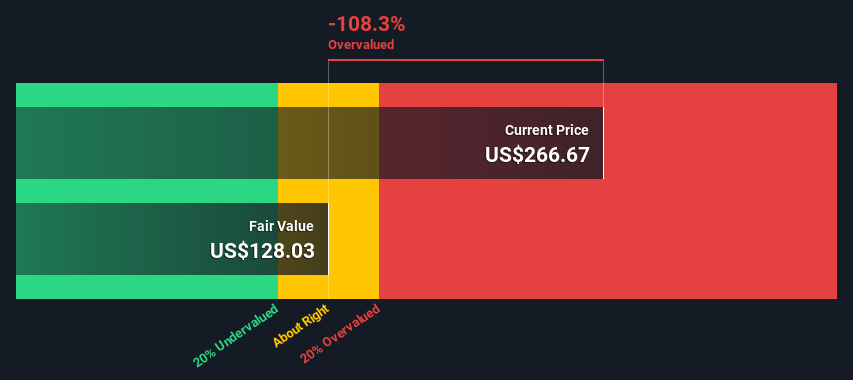- United States
- /
- IT
- /
- NYSE:SNOW
Snowflake (NYSE:SNOW) Needs to Prove the Doubters Wrong on Growth when Second Quarter Results are Released
Snowflake Inc. (NYSE:SNOW) is due to report second quarter financial results tomorrow. The stock price dropped sharply last week after research firm Cleveland Research issued a bearish report on the stock . Although the share price has recovered most of last week’s losses, the selloff illustrates just how sensitive the stock is to negative news. This shouldn’t really be surprising when you look at the valuation the market has placed on the stock.
Snowflake has a compelling story. And, the fact that Warren Buffett’s Berkshire Hathaway was an early investor has given investors even more confidence in the company. However, at some level the stock would be overvalued, which would mean further upside becomes less likely.
How much is Snowflake Worth?
Valuations are always subjective, and only as good as their inputs. But it’s always worth trying to get an idea of how much growth is being discounted by a share’s valuation. We can do this by plugging the analyst forecast into a Discounted Cash Flow (DCF) model and then comparing the implied valuation to the current share price. If you want to know more about this approach to valuation, take a look at the Simply Wall St analysis model .
View our latest analysis for Snowflake
Step by step through the calculation
We're using the 2-stage growth model, which simply means we take into account two stages of a company's growth. In the initial period the company may have a higher growth rate and the second stage is usually assumed to have a stable growth rate. To begin with, we have to get estimates of the next ten years of cash flows. Where possible we use analyst estimates, but when these aren't available we extrapolate the previous free cash flow (FCF) from the last estimate or reported value. We assume companies with shrinking free cash flow will slow their rate of shrinkage, and that companies with growing free cash flow will see their growth rate slow, over this period. We do this to reflect that growth tends to slow more in the early years than it does in later years.
Generally we assume that a dollar today is more valuable than a dollar in the future, so we discount the value of these future cash flows to their estimated value in today's dollars:
10-year free cash flow (FCF) estimate
| 2022 | 2023 | 2024 | 2025 | 2026 | 2027 | 2028 | 2029 | 2030 | 2031 | |
| Levered FCF ($, Millions) | US$3.13m | US$104.5m | US$272.9m | US$545.2m | US$1.05b | US$1.48b | US$1.91b | US$2.32b | US$2.68b | US$2.98b |
| Growth Rate Estimate Source | Analyst x17 | Analyst x17 | Analyst x8 | Analyst x4 | Analyst x4 | Est @ 41.22% | Est @ 29.45% | Est @ 21.21% | Est @ 15.45% | Est @ 11.41% |
| Present Value ($, Millions) Discounted @ 7.1% | US$2.9 | US$91.1 | US$222 | US$414 | US$743 | US$980 | US$1.2k | US$1.3k | US$1.4k | US$1.5k |
("Est" = FCF growth rate estimated by Simply Wall St)
Present Value of 10-year Cash Flow (PVCF) = US$7.9b
The second stage is also known as Terminal Value, this is the business's cash flow after the first stage.The Gordon Growth formula is used to calculate Terminal Value at a future annual growth rate equal to the 5-year average of the 10-year government bond yield of 2.0%. We discount the terminal cash flows to today's value at a cost of equity of 7.1%.
Terminal Value (TV) = FCF 2031 × (1 + g) ÷ (r - g) = US$3.0b× (1 + 2.0%) ÷ (7.1%- 2.0%) = US$60b
Present Value of Terminal Value (PVTV) = TV / (1 + r) 10 = US$60b÷ ( 1 + 7.1%) 10 = US$30b
The total value, or equity value, is then the sum of the present value of the future cash flows,which in this case is US$38b.The last step is to then divide the equity value by the number of shares outstanding.Compared to the current share price of US$267, the company appearsfactoring in a lot of growthand so the big question becomes: why is this stock so pricey?The assumptions in any calculation have a big impact on the valuation, so it is better to view this as a rough estimate, not precise down to the last cent.

The assumptions
Now the most important inputs to a discounted cash flow are the discount rate, and of course, the actual cash flows. Part of investing is coming up with your own evaluation of a company's future performance, so try the calculation yourself and check your own assumptions. The DCF also does not consider the possible cyclicality of an industry, or a company's future capital requirements, so it does not give a full picture of a company's potential performance. Given that we are looking at Snowflake as potential shareholders, the cost of equity is used as the discount rate, rather than the cost of capital (or weighted average cost of capital, WACC) which accounts for debt. In this calculation we've used 7.1%, which is based on a levered beta of 1.083. Beta is a measure of a stock's volatility, compared to the market as a whole. We get our beta from the industry average beta of globally comparable companies, with an imposed limit between 0.8 and 2.0, which is a reasonable range for a stable business.
What does this mean for Snowflake’s Second Quarter Earnings Release?
Based on current growth forecasts, Snowflake appears significantly overvalued. However companies can remain overvalued for years if investors believe in their long term potential. And, if it turns out that current forecasts are too conservative, the market price may not be too high.
Over the last four quarters revenue growth has drifted from 120% year-on-year down to 110%, Current forecasts suggest that growth will fall to 88% this year, 64% next year, and 56% in 2023. This leaves a lot of room for Snowflake to outperform current expectations.
As we pointed out recently, Snowflake has plenty of cash to fund growth over the coming years , so the only real issue is the current valuation and the likely growth rate over the next few years. The market will get an idea of how accurate the current forecasts appear when Snowflake reports tomorrow. You can track any changes on our free analyst growth expectation chart after the company releases second quarter results.
If you would like to consider some other all rounder stocks, have a look at our interactive list of high quality stocks to get an idea of what else is out there you may be missing!
PS. The Simply Wall St app conducts a discounted cash flow valuation for every stock on the NYSE every day. If you want to find the calculation for other stocks just search here .
Mobile Infrastructure for Defense and Disaster
The next wave in robotics isn't humanoid. Its fully autonomous towers delivering 5G, ISR, and radar in under 30 minutes, anywhere.
Get the investor briefing before the next round of contracts
Sponsored On Behalf of CiTechNew: Manage All Your Stock Portfolios in One Place
We've created the ultimate portfolio companion for stock investors, and it's free.
• Connect an unlimited number of Portfolios and see your total in one currency
• Be alerted to new Warning Signs or Risks via email or mobile
• Track the Fair Value of your stocks
Have feedback on this article? Concerned about the content? Get in touch with us directly. Alternatively, email editorial-team@simplywallst.com
Simply Wall St analyst Richard Bowman and Simply Wall St have no position in any of the companies mentioned. This article is general in nature. We provide commentary based on historical data and analyst forecasts only using an unbiased methodology and our articles are not intended to be financial advice. It does not constitute a recommendation to buy or sell any stock and does not take account of your objectives, or your financial situation. We aim to bring you long-term focused analysis driven by fundamental data. Note that our analysis may not factor in the latest price-sensitive company announcements or qualitative material.

Richard Bowman
Richard is an analyst, writer and investor based in Cape Town, South Africa. He has written for several online investment publications and continues to do so. Richard is fascinated by economics, financial markets and behavioral finance. He is also passionate about tools and content that make investing accessible to everyone.
About NYSE:SNOW
Snowflake
Provides a cloud-based data platform for various organizations in the United States and internationally.
Excellent balance sheet with limited growth.
Similar Companies
Market Insights
Weekly Picks

Early mover in a fast growing industry. Likely to experience share price volatility as they scale


A case for CA$31.80 (undiluted), aka 8,616% upside from CA$0.37 (an 86 bagger!).


Moderation and Stabilisation: HOLD: Fair Price based on a 4-year Cycle is $12.08
Recently Updated Narratives


An amazing opportunity to potentially get a 100 bagger

Amazon: Why the World’s Biggest Platform Still Runs on Invisible Economics

Sunrun Stock: When the Energy Transition Collides With the Cost of Capital
Popular Narratives


MicroVision will explode future revenue by 380.37% with a vision towards success


Crazy Undervalued 42 Baggers Silver Play (Active & Running Mine)


NVDA: Expanding AI Demand Will Drive Major Data Center Investments Through 2026
Trending Discussion

